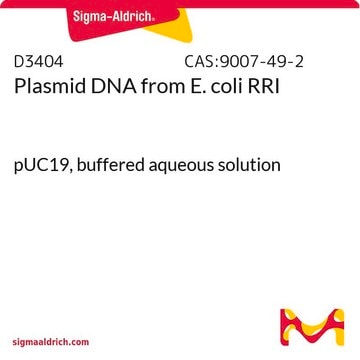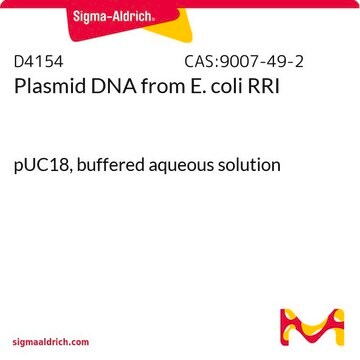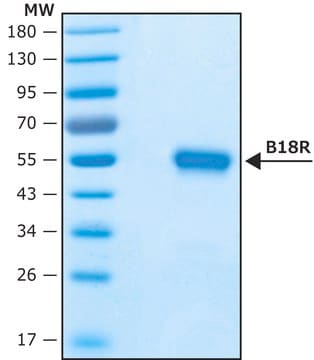E7283
p3XFLAG-myc-CMV™-26 Expression Vector
shuttle vector for transient or stable intracellular dual tagged expression of N-terminal 3xFLAG and C-term c-myc
Iniciar sesiónpara Ver la Fijación de precios por contrato y de la organización
About This Item
Código UNSPSC:
12352200
Productos recomendados
etiqueta
3X FLAG tagged (N-terminal)
c-Myc tagged (C-terminal)
grado
for molecular biology
Formulario
buffered aqueous solution
Condiciones de envío
dry ice
temp. de almacenamiento
−20°C
Descripción general
The p3XFLAG-Myc-CMV -26 Expression Vector is a 6.3 kb derivative of pCMV5 used to establish transient or stable intracellular expression of dual tagged N-terminal 3XFLAG and C-terminal c-myc fusion proteins in mammalian cells. The vector encodes three adjacent FLAG epitopes (Asp-Tyr-Lys-Xaa-Xaa-Asp) and a c-myc epitope (EQKLISEEDL) upstream and downstream of the multiple cloning sites, respectively. The third FLAG epitope includes the enterokinase recognition sequence, allowing cleavage of the 3XFLAG peptide from the purified fusion protein. The incorporation of 3XFLAG in the expression vector results in increased detection sensitivity using ANTI-FLAG M2 antibody. Efficiency of replication is optimal when using an SV40 T antigen expressing host.
The p3XFLAG-CMV-7-BAP Control Plasmid is a 6.2 kb derivative of pCMV5 used for transient intracellular expression of N-terminal 3X-FLAG bacterial alkaline phosphatase fusion protein in mammalian cells. The vector encodes three adjacent FLAG epitopes (Asp- Tyr-Lys-Xaa-Xaa-Asp) upstream of the multiple cloning region. This results in increased detection sensitivity using ANTI-FLAG M2 antibody. The third FLAG epitope includes the enterokinase recognition sequence, allowing cleavage of the 3XFLAG peptide from the purified fusion protein.
Vector Maps and Sequences
The p3XFLAG-CMV-7-BAP Control Plasmid is a 6.2 kb derivative of pCMV5 used for transient intracellular expression of N-terminal 3X-FLAG bacterial alkaline phosphatase fusion protein in mammalian cells. The vector encodes three adjacent FLAG epitopes (Asp- Tyr-Lys-Xaa-Xaa-Asp) upstream of the multiple cloning region. This results in increased detection sensitivity using ANTI-FLAG M2 antibody. The third FLAG epitope includes the enterokinase recognition sequence, allowing cleavage of the 3XFLAG peptide from the purified fusion protein.
Vector Maps and Sequences
Componentes
- p3XFLAG-myc-CMV™-26 Expression Vector 20 μg (E6401) is supplied as 0.5 mg/ml in 10 mM Tris-HCl (pH 8.0) with 1 mM EDTA.
- p3XFLAG-CMV™-7-BAP Control Plasmid 20 μg (C7472) is supplied as 0.5 mg/ml in 10 mM Tris-HCl (pH 8.0) with 1 mM EDTA.
Principio
The promoter-regulatory region of the human cytomegalovirus drives transcription of FLAG® and c-myc fusion constructs. The aminoglycoside phosphotransferase II gene (Neo-r) confers resistance to aminoglycosides such as G 418 allowing for selection of stable transfectants.
Información legal
This product is covered by the following patents owned by Sigma-Aldrich Co. LLC: US6,379,903, US7,094,548, JP4405125,EP1220933, CA2386471 and AU774216.
FLAG is a registered trademark of Merck KGaA, Darmstadt, Germany
p3xFLAG-CMV is a trademark of Sigma-Aldrich Co. LLC
p3xFLAG-Myc-CMV is a trademark of Sigma-Aldrich Co. LLC
Producto relacionado
Código de clase de almacenamiento
12 - Non Combustible Liquids
Clase de riesgo para el agua (WGK)
WGK 3
Punto de inflamabilidad (°F)
Not applicable
Punto de inflamabilidad (°C)
Not applicable
Equipo de protección personal
Eyeshields, Gloves, multi-purpose combination respirator cartridge (US)
Elija entre una de las versiones más recientes:
Certificados de análisis (COA)
Lot/Batch Number
¿No ve la versión correcta?
Si necesita una versión concreta, puede buscar un certificado específico por el número de lote.
¿Ya tiene este producto?
Encuentre la documentación para los productos que ha comprado recientemente en la Biblioteca de documentos.
Tania R Lizarbe et al.
FASEB journal : official publication of the Federation of American Societies for Experimental Biology, 22(9), 3207-3215 (2008-05-23)
Nitric oxide (NO) plays a critical role in wound healing, in part by promoting angiogenesis. However, the precise repair pathways affected by NO are not well defined. We now show that NO regulates matrix metalloproteinase-13 (MMP-13) release during wound repair.
William Stedman et al.
Journal of virology, 78(22), 12566-12575 (2004-10-28)
The viral genome of Kaposi's sarcoma-associated herpesvirus (KSHV) persists as an extrachromosomal plasmid in latently infected cells. The KSHV latency-associated nuclear antigen (LANA) stimulates plasmid maintenance and DNA replication by binding to an approximately 150-bp region within the viral terminal
Zhi Sheng et al.
Nature medicine, 16(6), 671-677 (2010-05-25)
Activating transcription factor-5 (ATF5) is highly expressed in malignant glioma and has a key role in promoting cell survival. Here we perform a genome-wide RNAi screen to identify transcriptional regulators of ATF5. Our results reveal an essential survival pathway in
Heena Dey et al.
BMC cell biology, 13, 27-27 (2012-11-01)
We previously demonstrated that p68 phosphorylation at threonine residues correlates with cancer cell apoptosis under the treatments of TNF-α and TRAIL (Yang, L. Mol Cancer Res Vol 3, pp 355-63 2005). In this report, we characterized the role of p68
Hongbo Fang et al.
PloS one, 8(7), e69600-e69600 (2013-07-31)
Breast cancer occur both in hereditary and sporadic forms, and the later one comprises an overwhelming majority of breast cancer cases among women. Numerical and structural alterations involving chromosome 8, with loss of short arm (8p) and gain of long
Nuestro equipo de científicos tiene experiencia en todas las áreas de investigación: Ciencias de la vida, Ciencia de los materiales, Síntesis química, Cromatografía, Analítica y muchas otras.
Póngase en contacto con el Servicio técnico







